[en/fr] History of JianZhan and Tenmoku ware
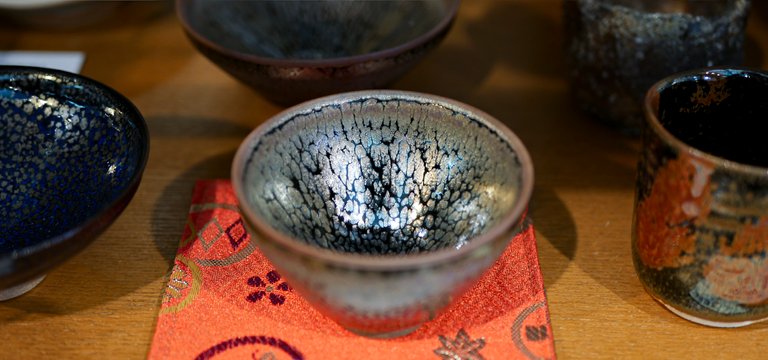
JianZhan and Tenmoku are in reality the same technique and produce these gorgeous silver oil drop patterns on ceramic wares.
JianZhan is the Chinese name and also the root of Tenmoku.
JianZhan was originally produced in the city of Jianyang in the Fujian province. The technique probably already existed for a long time, but it became prevalent during the Song dynasty (960-1279). JianZhan bowls were used for tea in monasteries by monks and even by the emperor and his court.
JianZhan et Tenmoku sont en réalité deux appellations qui font référence à la même technique dont le propre est de créer ces motifs si particuliers en forme de goutte d'huile argentées.
JianZhan est l'appellation chinoise de la technique et aussi l'origine du Tenmoku.
La céramique de JianZhan provient de la ville de Jianyang, qui se situe dans l'actuelle province du Fujian. Il est difficile de donner une date précise de l'invention de cette technique mais elle a reçu ses lettres de noblesse pendant la dynastie de Song (960-1279). Les bols à thé en céramique JianZhan étaient utilisés par les moines mais aussi par l'empereur et la noblesse en général.
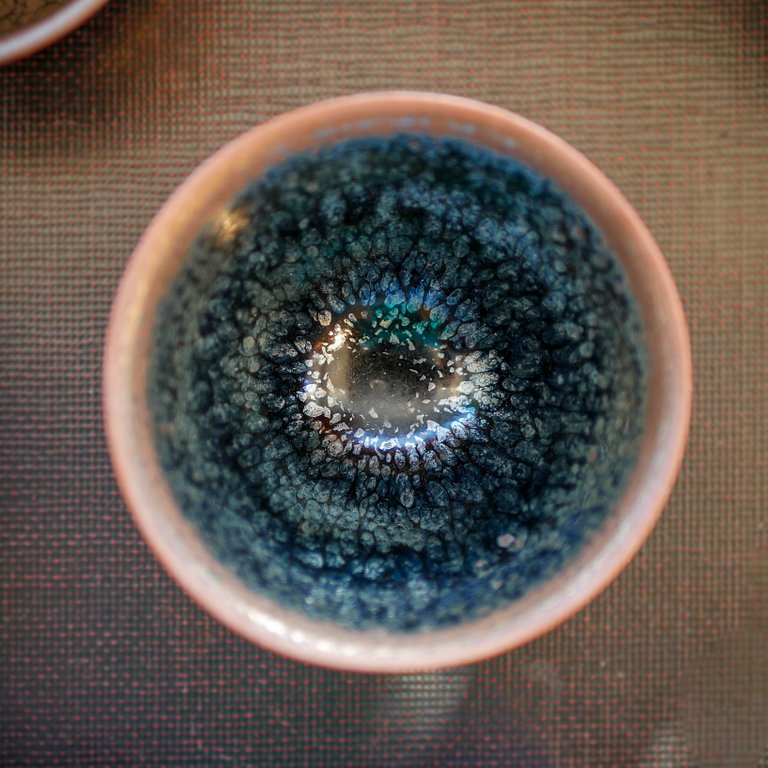
The particularity of JianZhan ware is its glaze: it creates this typical blue and shiny silver pattern that is truly mesmerizing.
The patterns are created during the firing in a step called: "transmutation". How cool is that! Well, it is not truly alchemy, but rather the result of centuries of research about clay and glaze. From a chemical point of view, it is mainly due to the high iron content in the clay. When firing at very high temperatures (around 1300°C) in an environment rich in oxygen, the iron reacts and forms this gorgeous pattern.
La particularité du JianZhan est son glaçage si particulier donnant une couleur bleuté avec des motifs argentés. Je trouve ces motifs vraiment magnifiques, presque hypnotisant!
Les motifs argentés sont créés pendant la cuisson au cours d'une opération nommée "la transmutation". Plutôt impressionnant comme nom mais ce n'est malheureusement pas vraiment de l'alchimie. C'est en revanche le résultat de plusieurs siècles de recherches pour développer la bonne argile et le bon glaçage. D'un point de vue plus terre-à-terre, on sait que la caractéristique important de cette argile est sa haute teneur en fer. Lors de la cuisson à plus de 1300°C dans un environnement riche en oxygène, le fer réagit et forme les fameux motifs argentés.
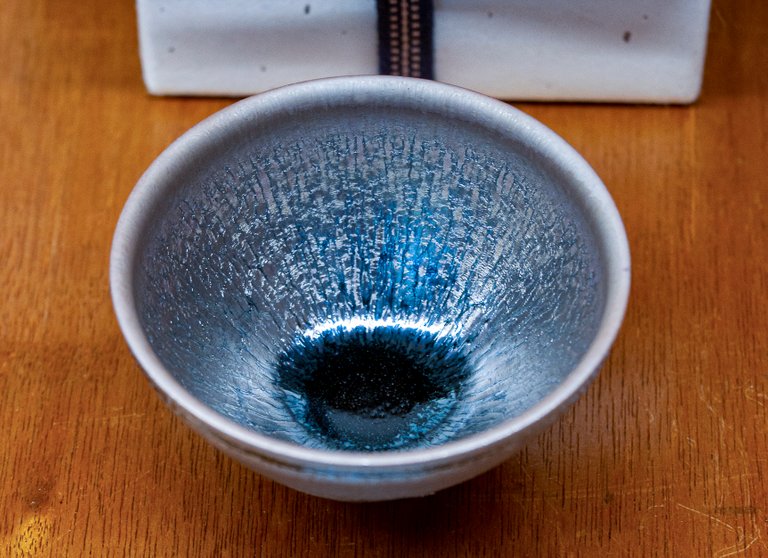
Transfer to Japan and the birth of Tenmoku
During the 14th century, the Emperor of China sent Jianzhan bowls to the Japanese Shogun who genuinely liked them.
As a result, more pieces were brought back from China, mainly by Japanese monks who traveled to Chinese monasteries.
And eventually, Japanese pottery masters succeeded in replicating the style, and the production of Tenmoku wares started. It progressively replaced the Chinese importations and eventually entirely replaced the JianZhan wares.
Indeed, in the meantime, the nobility in China turned toward other techniques. Since they were the main customers of such bowls, the JianZhan kilns had no choice but to stop their production.
Transfert au Japon et naissance du Tenmoku
Au cours du 14ème siècle, l'empereur de Chine envoya des bols Tenmoku au Shogun Japonais qui les apprécia beaucoup.
En conséquence, davantage de pièces furent rapportées de chine, principalement par des moines japonais partis en pèlerinage en chine.
Ainsi, les artisans japonais réussirent à leur tour à reproduire la technique et c'est ainsi que le Tenmoku est apparu. Les Tenmoku ont progressivement remplacé les importations chinoises jusqu'à complètement les supplanter.
En effet, dans le même temps la noblesse chinoise s'est désintéressée des JianZhan et s'est tournée vers d'autres techniques. Étant les principaux clients des fours JianZhann ces derniers n'ont eu d'autre choix que de cesser leur activité.
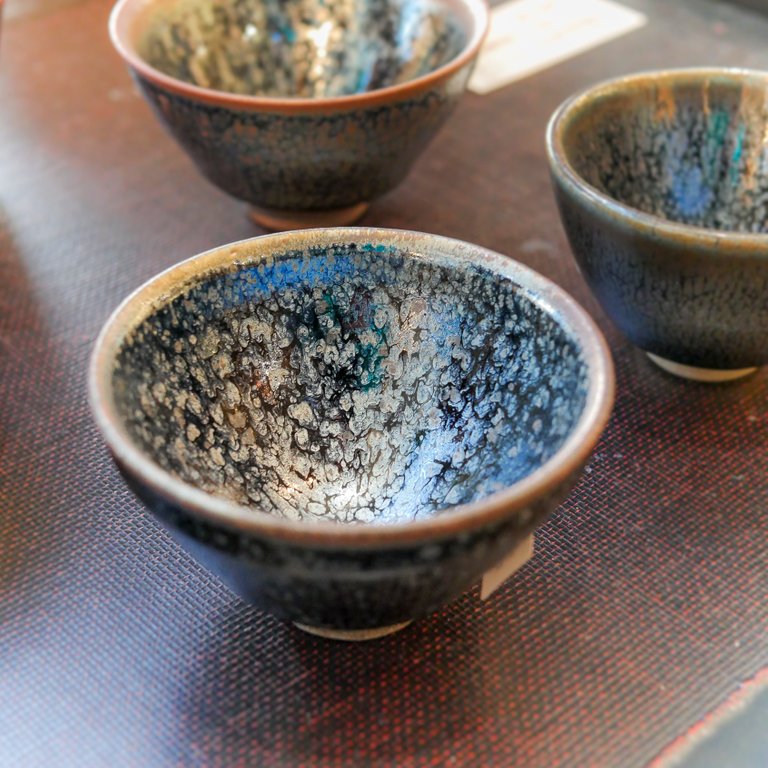
Thus the Japanese Tenmoku, heir of the Chinese JianZhan was the only representative of such ware for centuries until the years 1990's!
At that time, and because of renewed interest in ancient JianZhan wares, a small group of pottery masters managed to re-discover the long-forgotten secrets of their fabrication. They restarted the production of JianZhan wares in Shuiji, Fujian which is also the origin of one of the most prized tea in China: the Rock Oolong of WuYi mountain.
(Note Shuiji and Jianyang are very close localities)
C'est ainsi que le Tenmoku japonais fut le seul représentant de la technique JianZhan pendant plusieurs siècles et ce, jusque dans les années 1990!
Dans les années 90, en raison d'un nouvel intérêt pour les poteries anciennes de JianZhan, un petit groupe de maîtres potiers a entrepris des recherches pour retrouver les secrets perdus de la production JianZhan. Ils ont réussi à faire redémarrer la production à Shuiji dans la province du Fujian. A noter que Shuiji est aussi le berceau de l'un des thés les plus réputés au monde: les Oolong des rochers des Monts WuYi.
(Note: Shuiji et Jianyand sont 2 villes voisines)
Nowadays, both China and Japan produce JianZhan/Tenmoku wares, but the most prized ones are the old JianZhan bowls from the Song and Ming dynasties. They are often considered priceless and listed on the national treasure list of their country.
De nos jour, la Chine et le Japon fabriquent tous deux leur propres JianZhan/Tenmoku, cependant les pièces les plus prisées restent les anciens bols à thé chinois datant des dynasties Song et Ming. Ces bols sont si précieux qu'ils sont souvent listés parmi les trésors nationaux du pays qui les détient.
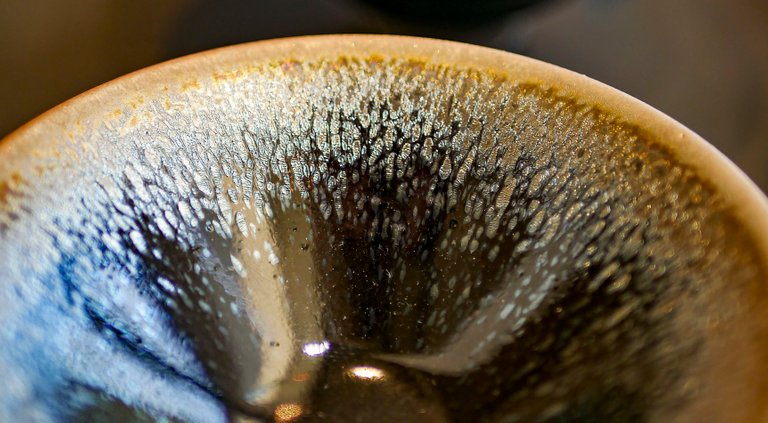
All pictures in this post are mine.
Feel free to leave a comment/reblog/follow if you want more posts about Japan and tea!
I am looking forward to your comments and I'll be happy to answer your questions so do not hesitate!

Congratulations @emeraldtiger! You have completed the following achievement on the Hive blockchain and have been rewarded with new badge(s):
Your next target is to reach 400 upvotes.
You can view your badges on your board and compare yourself to others in the Ranking
If you no longer want to receive notifications, reply to this comment with the word
STOPCheck out the last post from @hivebuzz:
Support the HiveBuzz project. Vote for our proposal!